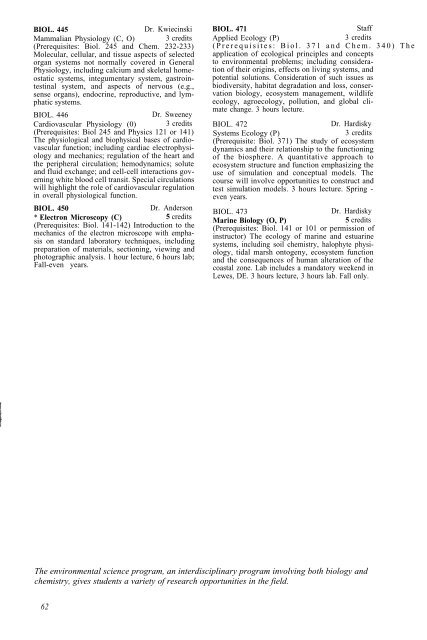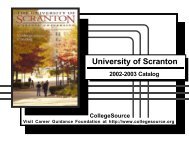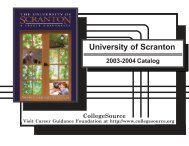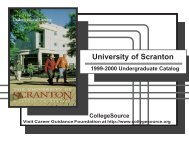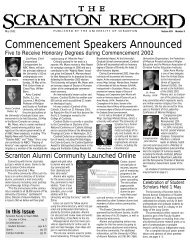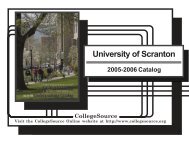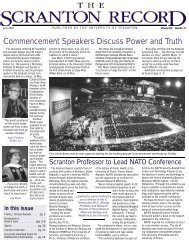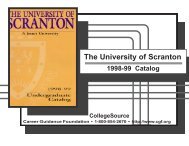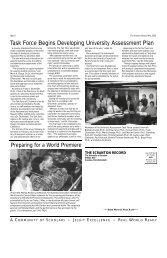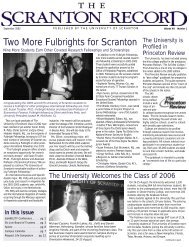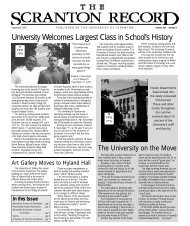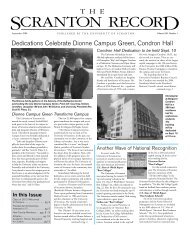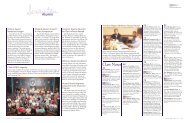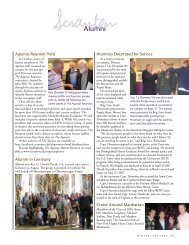Create successful ePaper yourself
Turn your PDF publications into a flip-book with our unique Google optimized e-Paper software.
BIOL. 445 Dr. Kwiecinski<br />
Mammalian Physiology (C, O) 3 credits<br />
(Prerequisites: Biol. 245 and Chem. 232-233)<br />
Molecular, cellular, and tissue aspects <strong>of</strong> selected<br />
organ systems not normally covered in General<br />
Physiology, including calcium and skeletal homeostatic<br />
systems, integumentary system, gastrointestinal<br />
system, and aspects <strong>of</strong> nervous (e.g.,<br />
sense organs), endocrine, reproductive, and lymphatic<br />
systems.<br />
BIOL. 446 Dr. Sweeney<br />
Cardiovascular Physiology (0) 3 credits<br />
(Prerequisites: Biol 245 and Physics 121 or 141)<br />
<strong>The</strong> physiological and biophysical bases <strong>of</strong> cardiovascular<br />
function; including cardiac electrophysiology<br />
and mechanics; regulation <strong>of</strong> the heart and<br />
the peripheral circulation; hemodynamics; solute<br />
and fluid exchange; and cell-cell interactions governing<br />
white blood cell transit. Special circulations<br />
will highlight the role <strong>of</strong> cardiovascular regulation<br />
in overall physiological function.<br />
BIOL. 450 Dr. Anderson<br />
* Electron Microscopy (C) 5 credits<br />
(Prerequisites: Biol. 141-142) Introduction to the<br />
mechanics <strong>of</strong> the electron microscope with emphasis<br />
on standard laboratory techniques, including<br />
preparation <strong>of</strong> materials, sectioning, viewing and<br />
photographic analysis. 1 hour lecture, 6 hours lab;<br />
Fall-even years.<br />
BIOL. 471 Staff<br />
Applied Ecology (P) 3 credits<br />
(Prerequisites: Biol. 371 and Chem. 340) <strong>The</strong><br />
application <strong>of</strong> ecological principles and concepts<br />
to environmental problems; including consideration<br />
<strong>of</strong> their origins, effects on living systems, and<br />
potential solutions. Consideration <strong>of</strong> such issues as<br />
biodiversity, habitat degradation and loss, conservation<br />
biology, ecosystem management, wildlife<br />
ecology, agroecology, pollution, and global climate<br />
change. 3 hours lecture.<br />
BIOL. 472 Dr. Hardisky<br />
Systems Ecology (P) 3 credits<br />
(Prerequisite: Biol. 371) <strong>The</strong> study <strong>of</strong> ecosystem<br />
dynamics and their relationship to the functioning<br />
<strong>of</strong> the biosphere. A quantitative approach to<br />
ecosystem structure and function emphasizing the<br />
use <strong>of</strong> simulation and conceptual models. <strong>The</strong><br />
course will involve opportunities to construct and<br />
test simulation models. 3 hours lecture. Spring -<br />
even years.<br />
BIOL. 473 Dr. Hardisky<br />
Marine Biology (O, P) 5 credits<br />
(Prerequisites: Biol. 141 or 101 or permission <strong>of</strong><br />
instructor) <strong>The</strong> ecology <strong>of</strong> marine and estuarine<br />
systems, including soil chemistry, halophyte physiology,<br />
tidal marsh ontogeny, ecosystem function<br />
and the consequences <strong>of</strong> human alteration <strong>of</strong> the<br />
coastal zone. Lab includes a mandatory weekend in<br />
Lewes, DE. 3 hours lecture, 3 hours lab. Fall only.<br />
<strong>The</strong> environmental science program, an interdisciplinary program involving both biology and<br />
chemistry, gives students a variety <strong>of</strong> research opportunities in the field.<br />
62


